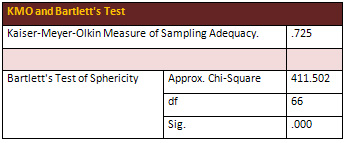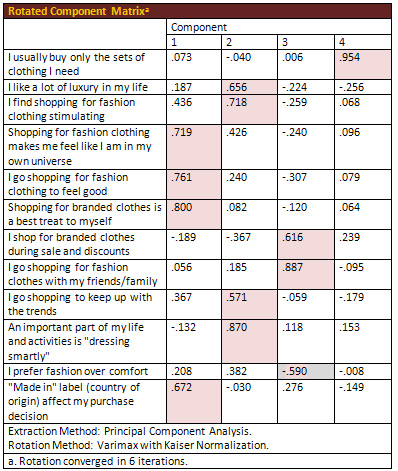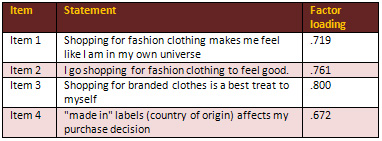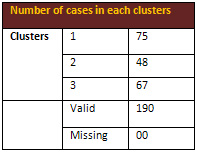|
Customer progression and perception
about premium men's apparel brands:
A case of Indian male professionals

Supriti Agarwal (1)
Sonia Singh (2)
(1) Assistant Professor,
Amity University, Noida, India
(2) Assistant Professor
Al Dar University College
Dubai, United Arab Emirates
Correspondence:
Dr Supriti Agarwal
Assistant Professor,
Amity University, Noida, India
Email: sagrawal2@amity.edu

Abstract
A
major challenge before companies today
is to understand the hybrid behavior
of the customer. On one side customers
are becoming price sensitive for bargains
and on the other they want to enjoy
world class brands and luxury goods.
Literature also shows that in recent
time there is a considerably huge
economic rise of disposable income
within the middle class which is leading
to consumption of branded products
in masses. Today luxury brand have
changed to affordable luxury brand
and will change to premium brands
in the near future. This study explores
the variables influencing consumer
progression and perception towards
premium brands. This study also explores
the relationship between demographics
and the brand preference. To accomplish
this task a questionnaire was prepared
and a total of 190 respondents who
have earned a professional degree
like engineering or management or
some higher educations like Ph.D were
interviewed. We have considered those
respondents who are employed in private
or government sectors only. It was
found that most consumers associated
greater accessibility of premium brands
in the Indian market with better quality,
though at higher price as they evaluate
them higher on quality, status and
esteem. This paper tries to segment
the market on the basis of different
clusters and also tries to find factors
affecting the perception of customers
for the buying of apparel.
Key
words: Customer perception, men's
apparel brands, Indian professionals

1. Introduction
With every passing year, intensity
of competition is becoming fiercer
due to globalization. Competition
is rising not only in differentiating
one product and service from another
but also in logistics, access to information
and so on. Now-a-days customers are
becoming more hybrid as they are not
only better informed but also they
have wider choices of less distinguishable
products due to easy access to internet
and online shopping trend. Across
the world customers are aware of their
increasing power due to which there
is a sharp increase in customers'
expectations from the companies in
terms of their basket of offerings
has been noticed. After New Economy
Policy 1991, the Indian economy noticed
a remarkable increase in the investment
by MNC's which in turn increases the
living standard of Indians, especially
the middle class who have the highest
marginal propensity to consume. Due
to all this in India high end luxury,
high value services, high information
access and high technology are increasing.
India is moving fast in each spectrum
be it retail, services, real estate,
hospitality on the consumer front
or value added B2B services or even
our capabilities in out sourcing at
company front. All these have given
a sharp increase in both income and
mindset of the middle class income
group, for them luxury is now a life
style not only a fashion statement.
Luxury items may be automobiles to
clothing, accessories, perfumes, all
are beating sales target in India.
2. Research
Purpose
Now in India with the advent of MNC's
and subsequent rise in white collar
jobs, the apparel industry, especially
in the men's segment, is increasing.
The young generation, especially in
management positions, are cognitively
orienting towards brands and trying
to find psychological identity by
grooming personality and self concept.
So in this paper we try to find the
factors affecting perception for buying
the premium brands and we also try
to segment the market for branded
apparels.
3. Literature
Review
Alden, D.I., Steenkamp, J.B. and Batra,
R., (1999), proposed, operationalized
and tested a new construct, GCCP-Global
Consumer Culture Position. This construct
associates the brand with a widely
understood and recognized set of symbols
believed to constitute emerging global
consumer culture. Holt, D.B., Quelech,
J.A., and Taylor, E.L. (2004) argued
that global branding should not be
interpreted as a call to rid traditional
brands of their national brands of
their national heritage, the two reasons.
Firstly, while globalness has become
a stronger quality signal than nation
of origin, consumers still prefer
brands that hail from countries that
are considered to have particular
expertise : Switzerland in chocolates,
Italy for clothing, France in cosmetic,
Germany in cars, Japan in electronics,
for example. More important, consumers
expect global brands to tell their
myths from the particular places that
are associated with the brand. For
Nestle to spin a credible myth about
food, the myth must be set in the
Swiss mountains, because that is where
people imagine the brand hails from.
As per Holt, D.B.(1995) there are
four types of consuming as experience
-- subjective, emotional reactions
to consumption objects, consuming
as integration -- consumer's acquire
and manipulate object meanings, consuming
as classification -- consumed objects
are used to classify consumers, consuming
as play -- how consumption objects
are used to play.
It is impossible to predict the culture
profile from the income position and
vice versa. There is an influence
of income and culture over the consumption
of luxury products. Income induces
consumers to acquire luxury goods.
The penetration of luxury goods is
at a maximum between the "wealth
on trend" (Doubois B and Duquesne,
P (1993). (Cesare Amatulli, Gianluigi
Guido, 2010) Consumers buy luxury
fashion goods mainly to match their
lifestyle, thus satisfying their inner
drives. The hierarchical value map
resulting from the data collection
and elaboration demonstrates that
self?confidence and self?fulfillment
are the main hidden final values when
buying and consuming luxury goods.
Implications for marketers are related
to tailoring products, brand values
and communication messages to the
subjective, self?rewarding and "internalized"
consumption sought after by consumers.
In their analysis Eng Tech-Young,
Bogaert Julie (2010) suggest that
luxury consumption conveys certain
identity through matching symbolic
meaning of luxury and consumption.
This identity is concerned with personal
values of wealth, status and socio
economic success derived from luxury
consumption. In this regard consumers'
perceptions of luxury are susceptible
to the reference group. In turn, reference
groups influence predilection for
luxury as part of extended self, but
with perceived uniqueness from combining
traditional Indian styles with the
possession of western luxury products.
In their result results Zhongqi Jin
and Bal Chansarkar, N.M. Kondap, (2006)
demonstrated that most consumers can
recognize the brand origin correctly
but the power of recognition decreases
when the brand has a long history
of "localization". Distinguished
trajectories of consumer perceptions'
of foreign brands and domestic brands
were projected, and this allowed one
to extend existing country of origin
(CO) research to brand of origin research.
In their research Mandel, N., Pertrova,
P.K. and Craldini, R.B.(2006) provides
a necessary examination of how consumers'
purchasing habits are influenced by
comparisons with individuals who are
wealthier and more successful than
themselves. The consumption of luxury
goods involves purchasing a product
that represents value to both the
individual and their reference group.
Referring to personal and interpersonal
oriented perceptions of luxury, it
is expected that different sets of
consumers would have different perceptions
of the luxury value for the same brands,
and that the overall luxury value
of a brand would integrate these perceptions
from different perspectives. Even
if the overall luxury value level
of a certain product or brand may
be perceived equally across national
borders, a differentiated measurement
may reveal that the overall luxury
value perception is a combination
of different evaluations with regard
to the sub-dimensions. Furthermore,
this differentiated perception of
luxury value may be dependent on the
cultural context and the people concerned
(Wiedmann, K.P., Hennigs N, Siebils
A, 2007).
4. Research
Methodology
Objectives:
The main objectives of the study are:
1. To evaluate the customer's
perception towards the purchase of
premium segment apparels.
2. To know whether the demographic
variables of respondent have influence
on selecting a premium brand.
3. To know the important variables
that influences the respondents in
purchasing a premium apparel brands.
Types of Research Methods Used
Phase 1: Premium segments are
relatively new in India. Luxury brand
from a recent past are considered
as premium brands today. There is
little empirical evidence to help
marketers fully understand what constitute
progression and perception towards
these brands. Therefore, the imperative
of the exploratory study is to gain
much needed background of information
pertaining to customer perception
towards premium apparel brands. This
exploratory study helped us in descriptive
research by developing the scales
for the survey instruments.
Phase 2: The purpose of the
descriptive research is to evaluate
the customer perception towards premium
brands, to know the important variable
that influences the respondent in
purchasing a premium apparel brand
and influence of demographic behavior.
For this we have used the followings:
• Factor Analysis
• Cluster Analysis
These are used to analyse and evaluate
customer progression and perception
towards premium brands.
Sampling:
As our research is mainly for the
men's section, they are also those
at management level positions and
those who have earned some higher
degree and are coming into high income
brackets, we have used convenient
sampling. While doing the pilot study
we came across one problem in our
demographic segment of questionnaire.
We asked the respondents about their
qualifications and we gave them options
like engineering, management study
or some higher study like PhD. In
our pilot study of 10 respondents
there was one respondent who had done
his engineering after that MBA and
also PhD. So to avoid confusing we
have considered only the higher education
of the respondents. So in the initial
stage of conducting the research we
took the sample size of 300 respondents
in order to collect relevant data
and all participants were made aware
of research intention and design by
an introduction. As time was limited
for the study, out of 300 distributed
we got 192 fully filled questionnaires
and out of 192 for the convenience
of research we discarded 2 questionnaires.
So this study was done with 190 respondents.
5. Discussion
on results
Demographic segmentation of respondents:
As our survey was related to men's
apparel all our respondents were men
only, but we had to be very careful
in choosing the sample. Almost 66%
of respondents are from age group
25 to 35 and the rest, 34 % are 35
years and above. Out of 190 respondents
almost 56% of respondents have done
a Masters in management, and then
almost 36% of respondents' highest
qualification was engineering. In
the income group almost 45% of respondents
were in income group 50000-70000 INR
and almost 38% for income group 30000-
50000 INR and 17% were above 70000
INR. Almost 76% of respondents were
in private jobs and the rest in government
jobs.
Table 1: Demographic Characteristics
of Respondents

Factor Analysis to identify important
factors:
Factor analysis attends to identify
underlying variables or factors that
explain the pattern of correlation
within a set of observed variables.
Factor analysis is often used in data
reduction, by identifying a smaller
number of factors which explains most
of the variant observed in a much
larger number of variables.
Sample Adequacy
A set of fourteen variables are considered
to be important to know the customer
shopping behavior for premium apparel
brands. These were subjected to principal
component analysis, using varimax
rotation with Kaiser Normalization
in order to reduce the multiplicity
of variable into selected factor.
First of all, let us observe the values
of Bartlett's Test of sphericity and
Kaiser-Meyor-Olkin(KMO) measure of
sampling adequacy.
Table 2: KMO and Bartlett's Test

As depicted in Table 2 the KMO measure
of sampling adequacy for this sample
was 0.725, which is greater than 0.5
and suggests that data is adequate
for factor analysis.
Interpretation of factors:
After this, factor analysis using
Varimax rotation and Kaiser Normalization
was conducted. As a result, four factors
were obtained. A rotated component
matrix along with factor is given
in the table below:
Table 3: Rotated Component Matrix

Factor C1: Shopping Stimulus
As shown in Table 4, all loadings
of item in factor C1 are significantly
high. Four variables with positive
loading are extracted in factor C
1. The positive loading indicates
that these four variables share most
of their variances between them and
thereby co-vary with each other. This
factor exhibits that the customer
finds shopping very stimulating, which
gives them a very happy feeling and
is a treat to them. In addition to
this, respondents prefer fashion over
comfort and dressing smartly is an
important activity in their life.
Table 4: Factor loadings of Factor
1

Factor C2: Brand Pullers
As depicted in Table 5, high positive
loading has been observed on some
variables. This variable shows that
customers give importance to their
self-actualization and Self-esteem
needs.
Table 5: Factor loadings of Factor
2

Factor C3: Shopping Delight
As depicted in Table 6, high positive
loading have been observed on the
variable - Buying branded clothes
give me a lot of pleasure. This variable
shows that customers give importance
to brands they buy which in return
give them pleasure
Table 6: Factor loadings of Factor
3

Factor C4: Self satisfied buyers
As depicted in Table 7, high positive
loading have been observed on the
variable- They enjoy the clothes what
they have and are very satisfied with
what they possess. This variable shows
that respondents hesitate to spend
money on premium brands.
Table 7: Factor loadings of Factor
4

Cluster Analysis for market segmentation:
Factor analysis, multidimensional
scaling and cluster analysis all are
interdependence techniques and no
distinction between dependent and
independent variables is made. Both
factor analysis and cluster analysis
are data reduction techniques but
the major difference is that factor
analysis is done by grouping variables
where as cluster analysis is by reducing
observations in a smaller number of
observations. So in order to identify
the market segment for different apparel
brands by grouping them in same cluster
we have performed cluster analysis
by using (K means) in Table 8.
Table 8: Cluster Analysis (K Means)

Interpretation of Cluster1: Premium
Brands Diehards
On the basis of the opinion of the
population towards the premium brands,
people belonging to this group are
highly influence by premium brands.
They consider premium brands as durable
and high quality. They strongly believe
that premium brands reflect their
personality and they do not mind paying
a high price for them. They enjoy
spending times in these stores as
it offers them a good shopping environment.
They believe that premium brands help
them gain face.
Profile: Premium brands diehards
are the customers with positive notions
about a brand, and are loyal customers
of these segments of apparels.
Interpretation of Cluster 2: Non
Fascinated Customer
On the basis of the opinion of the
population towards premium brands,
people belonging to this group agree
with the fact that premium brands
demonstrate success and social status.
But this set of population believes
premium brands do not help to gain
face and are unbiased on the quality
and durability of the products. They
strongly believe that premium brands
apparel is highly priced.
Profile: As the name suggests
non fascinated customer are unenthusiastic
about premium brands and do not show
a very high interest in purchasing
them.
Interpretation of Cluster 3: Consumer
on the Fence
On the basis of the preference and
the choice of premium brands, the
population of this set is in agreement
that premium brands are durable and
are of high quality. They do not strongly
agree that premium brands reflect
one's personality and social status
but are giving consent to the statement.
More emphasis should be given to this
set of consumers as they are highly
switchable and constitute the major
chunk of the same population.
Profile: Consumers on the fence are
highly switchable and can be turned
to loyal customers if taken care off.
6. Finding and
Conclusions
Indian consumer demonstrate unique
purchasing behavior due to the diversity
of the population, as we find all
age groups, income groups and educational
qualification people are using home
made products to most branded products.
It is very important to understand
the perception in such a vast and
growing market where the male population
is also becoming more brand conscious
and are constantly looking out for
global premium brand as they give
them a status, confidence and pleasure
of shopping. Research shows consumers
between the ages of 20-35 years have
been the prime market for premium
brands.
If we conclude the answer of the respondent,
we can say that they perceived premium
brands as quality products. This perception
can often serve as a rationale for
premium brands to charge high prices.
Consumers also believe that these
transnational companies compete by
trying to develop new products and
are very dynamic, always upgrading
themselves with respect to the fashion
and global trend.
References
1. Alden, D.I., Steenkamp,
J.B. and Batra, R., (1999),"
Brand positioning through advertising
in Asia, North America, and Europe:
The role of global consumer culture
", Journal of Marketing, Vol.63,
pp.75-87.
2. Atwal G. and Williame A.
"Luxury Brand Marketing - The
experience is everything!" Journal
of Brand Management ,Volume 16,pp-338-346
3. Cesare Amatulli, Gianluigi
Guido,(2010) "Determinant of
Purchasing Intentions for Fashion
Luxury Goods in Italian Market",
Journal of Fashion Marketing and Management,
Vol.15, Issue 1, pp.123-136.
4. Doubois B and Duquesne,
P (1993), " The market for luxury
goods: income vs culture", European
Journal of marketing, Vol.21,No. 1,pp.35-44.
5. Eng, Teck-Yong, Bogaert,
Julie," Psychological and cultural
insights into consumption of luxury
Western brand in India", Journal
of customer behavior, Vol.9, No.1
Spring 2010, pp.55-75)
6. Holt, D.B. (1995) "
How consumers consume : A typology
of consumption practices", Journal
of Consumer Research , Vol.22,No.6,
pp 1-16.
7. Holt, D.B., Quelech, J.A.,
and Taylor, E.L. (2004), "How
global brands compete ", Harvard
Business Review , Vol. 82 ,No.9, pp.68-75
8. Mandel, N., Petrova, P.K.
and Cialdini, R.B.(2006) , "
Images of success and the preference
for luxury brands", Journal of
Consumer Psychology ,Vol.16,No.1,pp.56-69
9. S. Ravichandran "Daily
News. Ik, Wednesday, 1st July 1999.
10. Wiedmann, K.P., Hennigs
N, Siebils A,(2007) "Measuring
Consumers' Luxury Value Perception:
A Cross-Cultural Framework" ,Academy
of Marketing Science , Vol,11,pp-1-21.
11. Zhongqi Jin and Bal Chansarkar,
N.M. Kondap, (2006) "Brand Origin
is an Emerging Market: Perception
of Indian Consumer", Asia Pacific
Journal of Marketing and Logistics,
Vol.18 Iss: 4, pp.283-302.

|